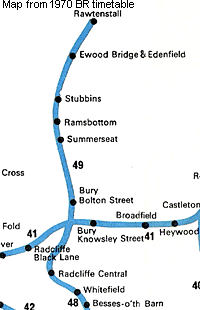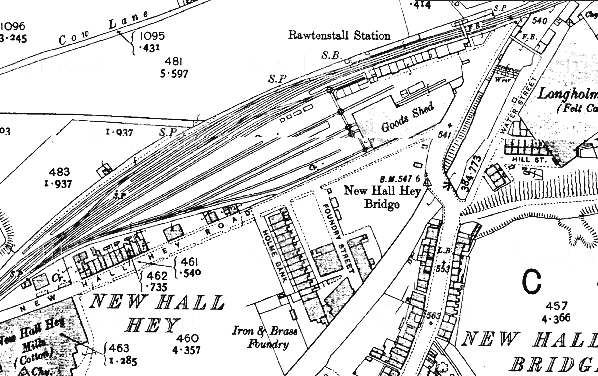Notes: Rawtenstall station was officially opened on 25th September 1846, and public services began on 28th September. The station was the northern terminus of the East Lancashire Railway (ELR) company’s Clifton Junction to Rawtenstall line which opened on the same date.
The idea for a line between Clifton Junction and Rawtenstall via Bury dated back to a meeting 24th September 1843, the outcome of which was the creation of the Manchester, Bury & Rossendale Railway (MB&RR). This company was formally incorporated on 4th July 1844. Whilst the line was under construction the MB&RR amalgamated with the Blackburn, Bury, Accrington & Colne Extension Railway, and on 21st July 1845 the new concern became the East Lancashire Railway. On 25th September 1846 a special train carrying 600 guests was the first official train to arrive at Rawtenstall. It set out from Manchester and included town officials amongst its passengers. At Rawtenstall they were treated to refreshments in a new weaving shed that belonged to John Robinson Kay.
 |
At the time of opening the line into Rawtenstall was single-track so the station had one platform on the south side of the line. There was a single-storey stone building which housed station offices and waiting rooms, under which cellars were provided for storage. A stationmaster’s house was also part of the facilities. Freight facilities including a goods shed were provided |
to the south and to the west of the station.
At the time of opening five passenger trains ran on weekdays in each direction between Manchester and Rawtenstall; there were four trains on Sundays.
On 17th August 1848 the ELR opened a route from Stubbins, four miles to the south of Rawtenstall, to Accrington. This created a main line from Clifton Junction to Accrington reducing the Stubbins to Rawtenstall line to the status of a branch line. On 27th March 1848 the Stubbins to Rawtenstall line was extended northwards to Waterfoot and, as a result, Rawtenstall became a through station. A level crossing was created at the north east end of the station where the line crossed Bury Road. Four years later, on 1st October1852, the Waterfoot line was extended to Bacup.
From July 1857 the line through Rawtenstall was doubled and an extra platform was provided on the north side of the line to handle trains towards Bacup. It was shorter than the original platform and was provided with single-storey wooden buildings. On13th May 1859 the Lancashire & Yorkshire Railway (LYR) absorbed the ELR. Under LYR ownership Rawtenstall station developed further and eventually included canopies on both platforms and a footbridge at the northeast end enabling passengers to cross the line without having to use the level crossing. There was a water tower at the end of the southbound platform, and cattle pens were installed just west of the station buildings, south of the line. Numerous sidings were laid out to the west of the station. Two signal boxes controlled the line through Rawtenstall: one was several hundred metres south west, on the north side of the line, and was called Rawtenstall West, whilst Rawtenstall East (opened in 1880) was close to the station on the north east side of Bury Road.
 |
During the early years of LYR ownership passenger train services from Rawtenstall continued to run to Manchester via Clifton Junction. From 1st September 1879 Rawtenstall’s passenger services to and from Manchester were transferred south of Bury from the route via Clifton Junction to a new line via Prestwich.
In 1914 the LYR introduced a ‘Rail-motor’ service – known affectionately as ‘Little Billie’ - between Ramsbottom and Bacup; this called at all stations, including Rawtenstall and supplemented trains that ran through to Manchester. From 11th April 1916 through passenger services to Manchester were diverted once more to travel via Heywood, adding a considerable mileage to their journeys. The reason for the change was that from this date electric services began on the Bury to Manchester (via Prestwich) line. Passengers for Manchester from Rawtenstall were encouraged to change onto the electric trains at Bury for a quicker onward journey, and most of them did so. Within a few years many southbound services terminated at Bury Bolton Street.
On 1st January 1923 Rawtenstall became part of the London Midland & Scottish Railway (LMS). By summer 1932 the station had thirty services travelling northbound to Bacup on weekdays. The first service which had originated from Ramsbottom left at 6:17 am. The last service which had originated from Bury Bolton Street left Rawtenstall for Bacup |
at 11:41 pm. Of the thirty services most trains had started from Bury Bolton Street or from Manchester Victoria., but one train began its journey at Bury Knowsley Street, and one came from Bolton. Some services had started from Ramsbottom. On Tuesday and Fridays only there was an additional service to Bacup at 5:44 pm which originated at Ramsbottom
| In the southbound direction there were twenty-eight weekday departures, the first being for Middleton Junction at 05:32 am. The last train was for Bury Bolton Street, and it left Rawtenstall at 10:21pm. The rest of the services tended to travel either to Manchester Victoria or Bury Bolton Street, but there were trains at 09:16am, 10:36am and 3:11pm which |
 |
went to Bury Knowsley Street, as well as shorter workings to Ramsbottom. There were also two services from Bacup that terminated at Rawtenstall.
On 1st January 1948 Rawtenstall became part of the nationalised British Railways (London Midland Region). In 1954 the line between Bury and Bacup was considered busy enough to warrant the introduction of modern rolling stock, and it was reported in the local press that new diesel multiple units (DMUs) were to be introduced; they entered service on the line in February 1956. Rawtenstall had thirty-five trains in each direction, giving a half-hourly service: the most intensive that the line would see.

|
The purpose of The Reshaping of British Railways (Beeching Report) of March 1963 was to create an economically viable network, involving the closure of many loss-making passenger lines and stations. The report’s proposals for Lancashire and north Manchester were astonishing. The entire route from Manchester via Bury Bolton Street to Bacup and |
Accrington was earmarked for closure, yet the nearby Manchester – Oldham – Rochdale and the Bolton – Bury Knowsley Street – Rochdale lines were not. The absurdity of withdrawing passenger services on the heavily used, electrified service between Manchester and Bury was acknowledged when, on 8th February 1965, the Minister of Transport refused consent to closure. However on 14th September 1966 the Minister gave permission for the Rawtenstall to Bacup and Bury to Accrington lines to close, which they did on 5th December 1966. (The final passenger train left Bacup on Saturday 3rd December.) Rawtenstall East signal box closed on 4th December 1966. For a short period up until 1968 goods services continued to run to a coal depot at Bacup but by 1969 the line had been lifted as far as Rawtenstall Station. Buffer stops were placed at the end of what was now the line from Bury at a point just short of the former level crossing.
Rawtenstall reverted to being a terminus, and the passenger train service became a shuttle between Bury Bolton Street and Rawtenstall. Goods services in the form of coal trains continued to serve the Rawtenstall goods yard which became a coal concentration depot on 2nd November 1964. From 2nd May 1966 this became a private coal siding. The original 1846 platform, which had been the southbound, was kept in use, and the later northbound platform was abandoned.
| The March 1967 timetable showed fifteen passenger services in each direction at irregular intervals, and two extra workings on Saturdays, one in the early afternoon and another late at night. No trains ran on Sundays. From 4th March 1968 Rawtenstall station became unmanned, and its buildings were demolished shortly afterwards. On 19th April 1970 the line from |
 |
Bury to Rawtenstall was singled. In the final year’s timetable from May 1971 weekday services had been reduced to twelve in each direction, with thirteen on Saturdays, the late night Saturday working having ceased by May 1970.
 |
On 5th June 1972 the passenger service was withdrawn, and Rawtenstall station closed completely. Freight trains continued to serve the coal depot until 1980. On 28th March 1982 a railtour visited Rawtenstall station, and after it had departed southwards the line was officially closed.
A preservation group, called the East Lancashire Railway after the original company, entered into negotiations with British Rail with a view to reopening the line from Bury to Rawtenstall. Supported by the local authorities, they were successful and opened the stretch of line from Bury to Ramsbottom on 25th July 1987 and onward to Rawtenstall on 27th April 1991. Once again trains started to serve Rawtenstall station, which has over the years been improved. On 16th April 1992 a fine new station building, in ELR style, was opened, occupying the former track-bed of the line to Bacup. Only a short section of the northbound platform still exists, but the original platform has |
been fully restored and lengthened. LMS-style gas lamp standards bearing reproduction maroon BR (LMR) totems lend an authentic 1950s atmosphere to this delightful station.
Tickets from Michael Stewart , route map drawn by Alan Young, timetable from Alan Young
Click here to see of film of a train journey between Bury and Bacup in 1966
See also the Ramsbottom Model Railway Club web site which features 106 old photographs of the East Lancashire Railway and photographs of the clubs excellent layout of Ramsbottom & Stubbins.
Sources:
To see other stations on the East Lancashire Railway Clifton Junction - Bacup line click on the station name on the station name: Clifton Junction, Molyneux Brow, Ringley Road, Radcliffe Bridge, Withens Lane, Bury Bolton Street, Summerseat, Ramsbottom, Stubbins, Irwell Vale (new station on the ELR), Ewood Bridge & Edenfield, Clough Fold, Waterfoot for Newchurch, Stacksteads & Bacup
See also Stubbins Junction to Accrington:
Helmshore, Haslingden, Baxenden & Accrington |

old15.jpg)


old2.jpg)
old9.jpg)
old10.jpg)
10.jpg)
old14.jpg)
14.jpg)
1.jpg)
13.jpg)
5.jpg)
30.jpg)



.gif)




 Home Page
Home Page